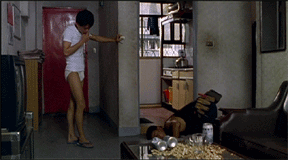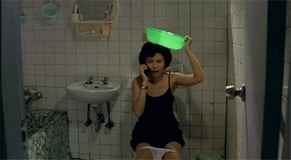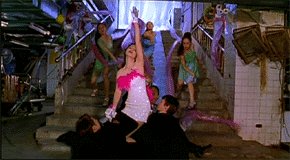The Hole (Tsai Ming-Liang) 1999
 Tsai Ming-Liang’s stripped down sci-fi film The Hole looks at our
future with a sense of bleak disdain. Set in the week before the year 2000, the
movie is set in a Taiwanese tenement that has been mostly evacuated because of
the outbreak of an epidemic that causes people to fear light, crawl around and
generally act like cockroaches. There are essentially two characters in the
film, and I’m not certain that either is graced with a name (the credits
simply call them “The Man Upstars” and “The Woman Downstairs”). Due to
the disease, the area that they are in, yet refuse to leave (for unstated
reasons), has been quarantined, with the government threatening to shut off the
water supply at the dawn of the millennium. Their lives seem to be exceptionally
empty, since any friends and family that they might have once had seems to have
already moved on. When a plumber leaves a hole in the floor, opening a gateway
between their rain soaked apartments it offers the chance for communication,
though nothing about achieving that desired connection is simple here.
Tsai Ming-Liang’s stripped down sci-fi film The Hole looks at our
future with a sense of bleak disdain. Set in the week before the year 2000, the
movie is set in a Taiwanese tenement that has been mostly evacuated because of
the outbreak of an epidemic that causes people to fear light, crawl around and
generally act like cockroaches. There are essentially two characters in the
film, and I’m not certain that either is graced with a name (the credits
simply call them “The Man Upstars” and “The Woman Downstairs”). Due to
the disease, the area that they are in, yet refuse to leave (for unstated
reasons), has been quarantined, with the government threatening to shut off the
water supply at the dawn of the millennium. Their lives seem to be exceptionally
empty, since any friends and family that they might have once had seems to have
already moved on. When a plumber leaves a hole in the floor, opening a gateway
between their rain soaked apartments it offers the chance for communication,
though nothing about achieving that desired connection is simple here.

Tsai’s film sets up a
complicated series of visual gags that demonstrate the corporeal and ethereal
barriers that exist between his characters. The incessant rain that floods the
apartment complex parodies the threat of an end to their water supply, and the
scenes in which we watch the characters urinate serve to remind us that our need
for water is almost a parody in itself, since we simply expel the bulk of it.
The titular hole between the apartments allows an opportunity for the director
to reference Rififi as well as a chance for Tsai to further reduce the
conditions that these humans live in. They casually listen to and peek at each
other through it, each yearning for the other, but when faced with each other in
person, the result is awkward.
 The pessimistic outlook that punctuates most of the film is
occasionally spruced up by musical dream sequences that the woman has, which
function similarly to those of Selma in Dancer in the Dark. Her wish
fulfillment is impossible in the hostile environment that she lives in however,
so it’s a bit of a mystery as to why she remains there. Perhaps, as her
stockpiles of toilet paper suggest, she’s a neurotic creature of habit, and
the prospect of change frightens her. The same could be said of the man as well,
and the underlying implication of the film seems to be that in modern society,
we’re not that different from cockroaches to begin with. Although the viral
outbreak in The Hole is eventually deemed “Taiwan fever”, the lack of
specificity in so many of the film’s other details suggests we’re meant to
see this state of affairs as a global affliction. The humor and ennui that
Tsai’s vision evokes in that condition is both unique and compelling.
The pessimistic outlook that punctuates most of the film is
occasionally spruced up by musical dream sequences that the woman has, which
function similarly to those of Selma in Dancer in the Dark. Her wish
fulfillment is impossible in the hostile environment that she lives in however,
so it’s a bit of a mystery as to why she remains there. Perhaps, as her
stockpiles of toilet paper suggest, she’s a neurotic creature of habit, and
the prospect of change frightens her. The same could be said of the man as well,
and the underlying implication of the film seems to be that in modern society,
we’re not that different from cockroaches to begin with. Although the viral
outbreak in The Hole is eventually deemed “Taiwan fever”, the lack of
specificity in so many of the film’s other details suggests we’re meant to
see this state of affairs as a global affliction. The humor and ennui that
Tsai’s vision evokes in that condition is both unique and compelling.
***1/2
03-04-02
Jeremy Heilman